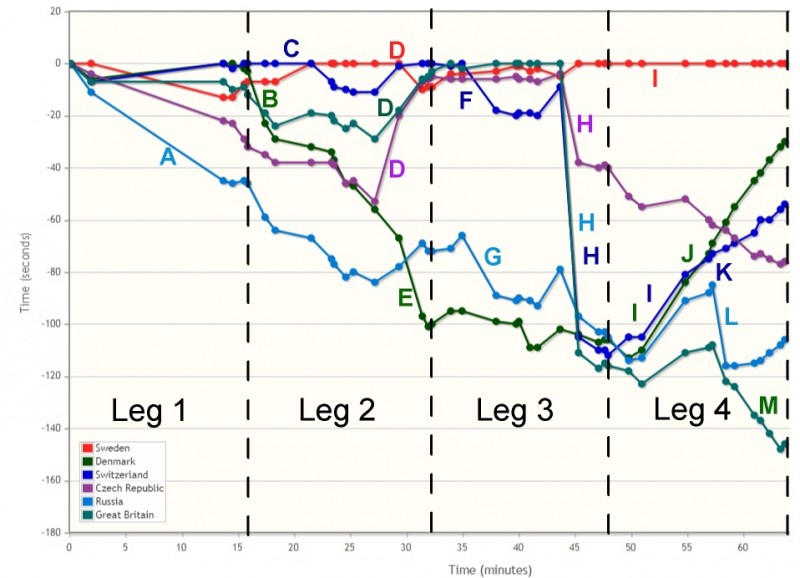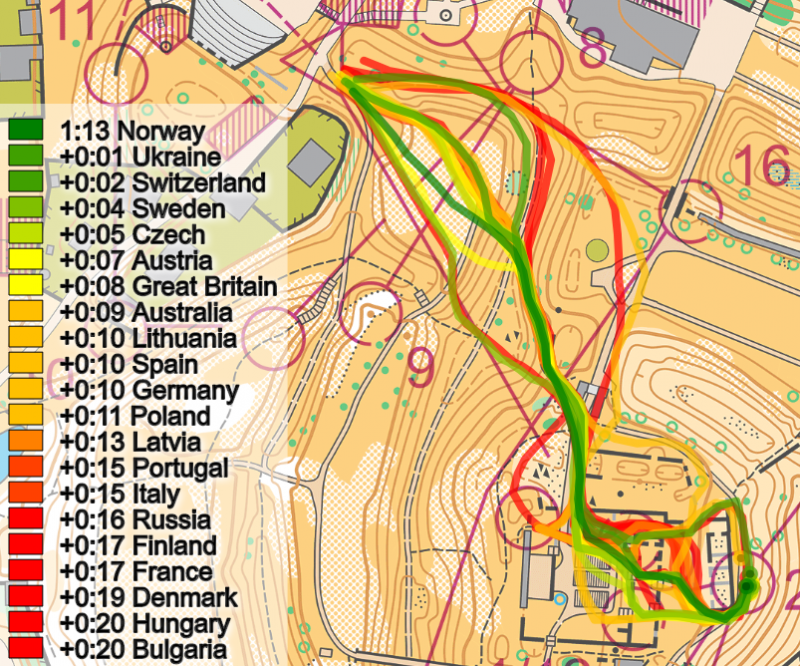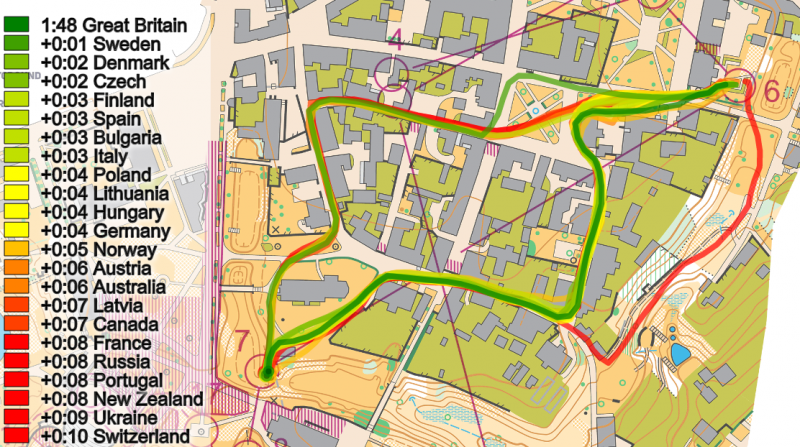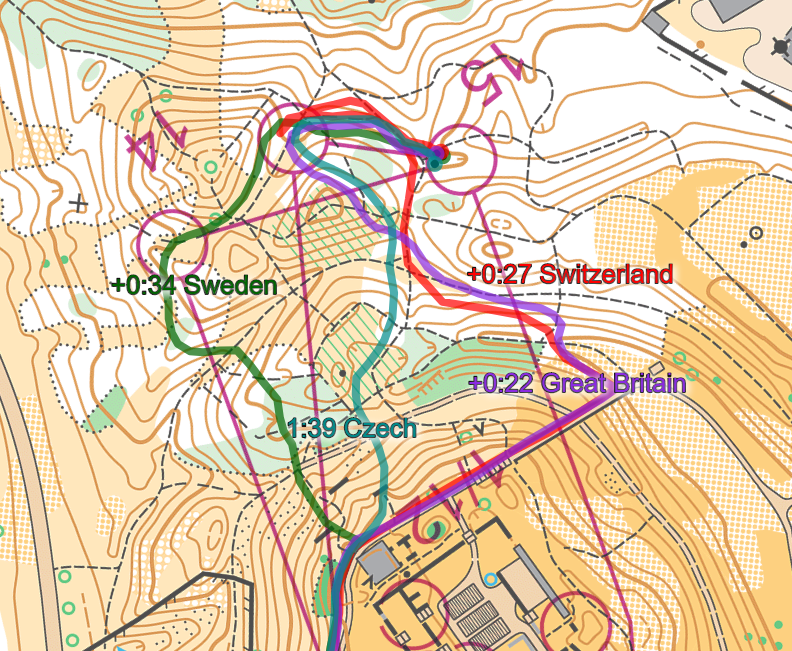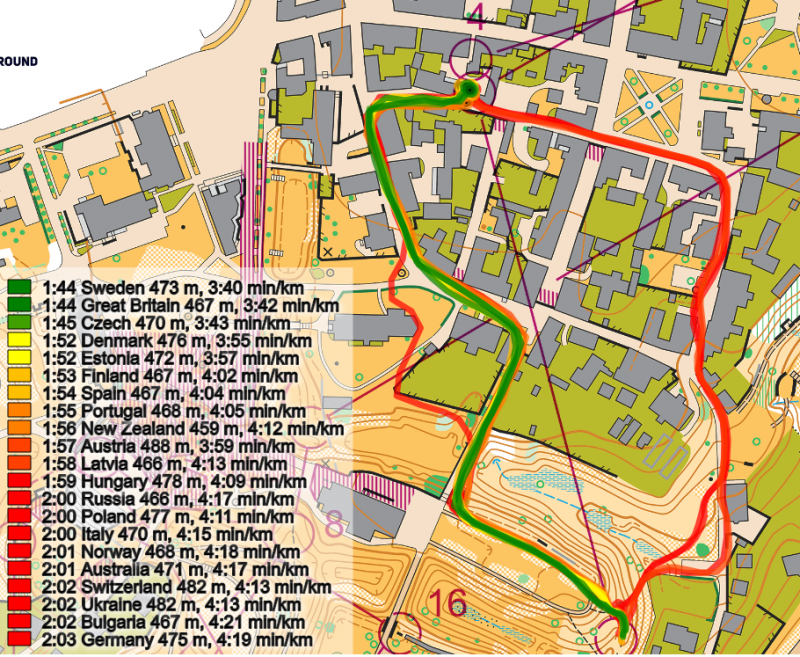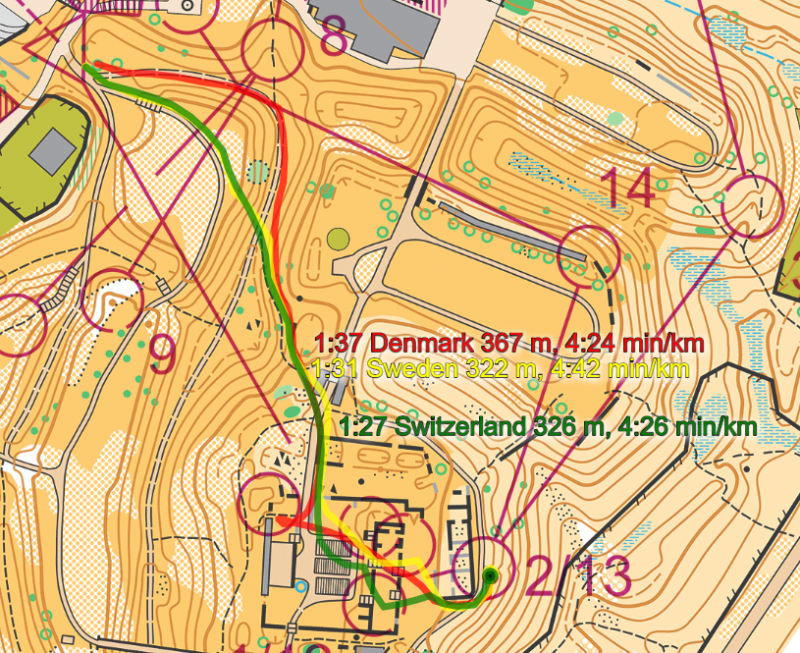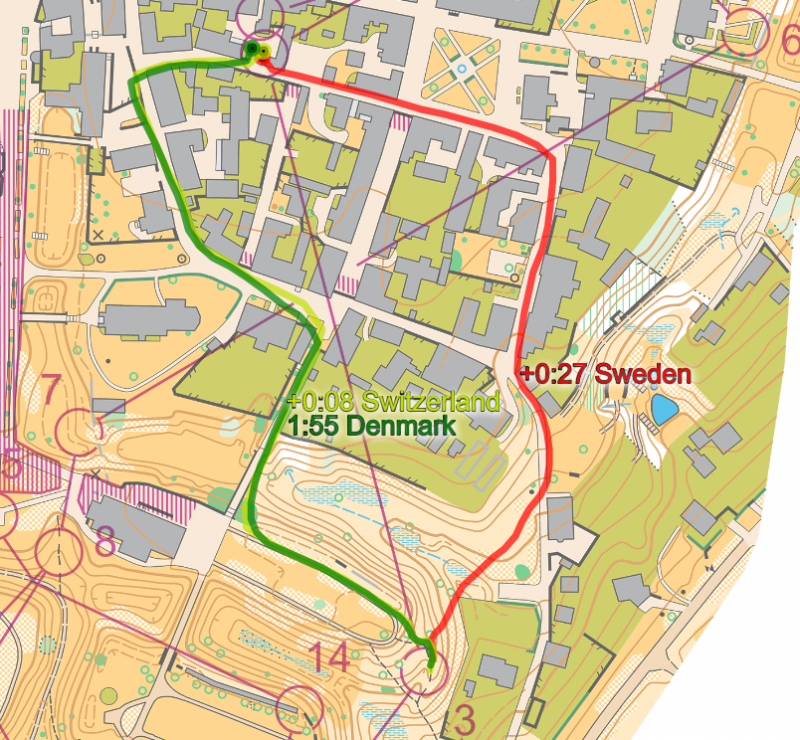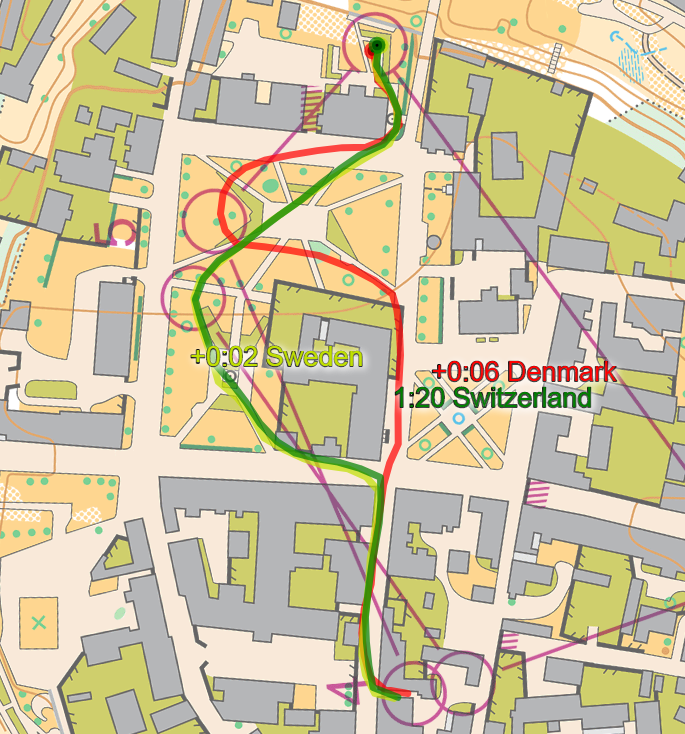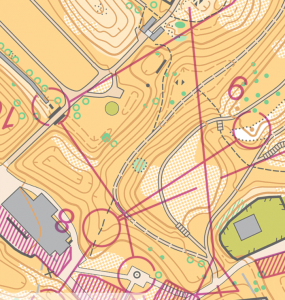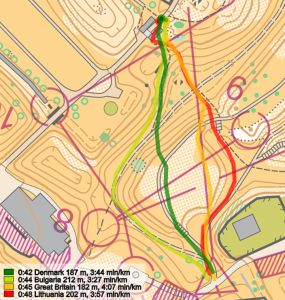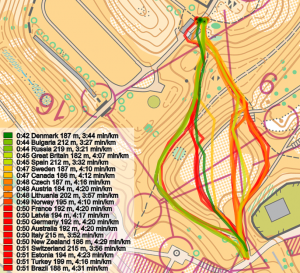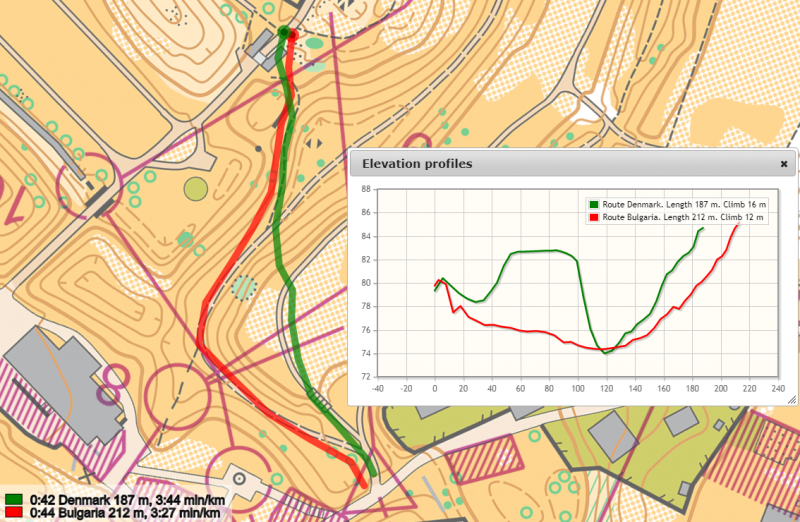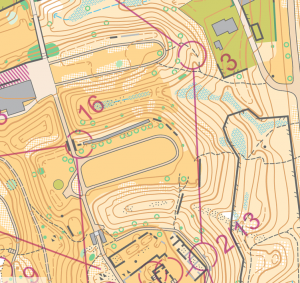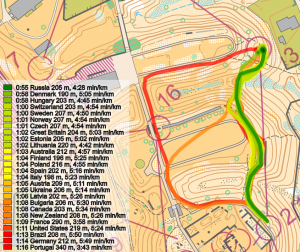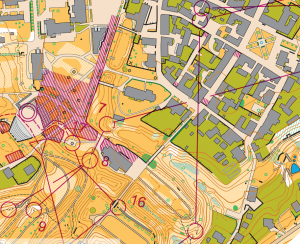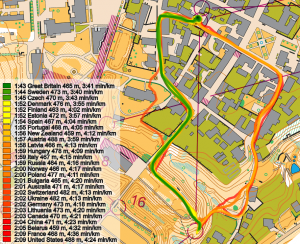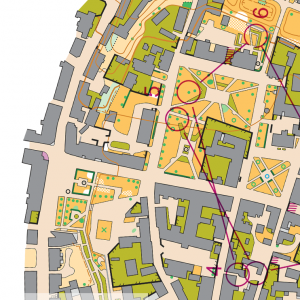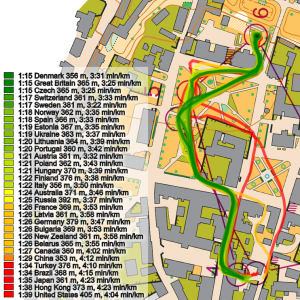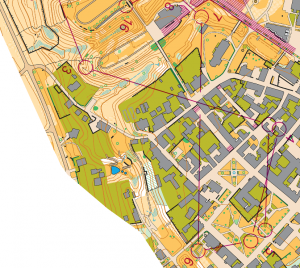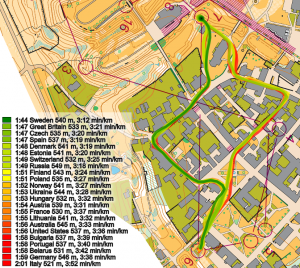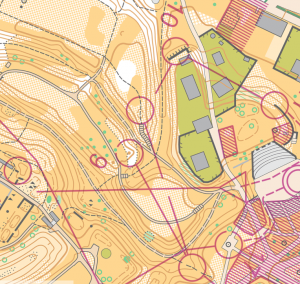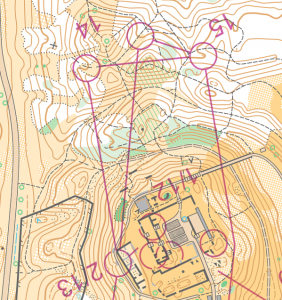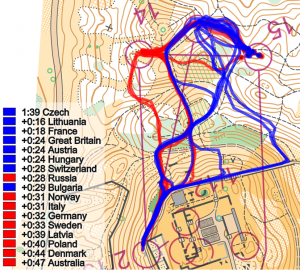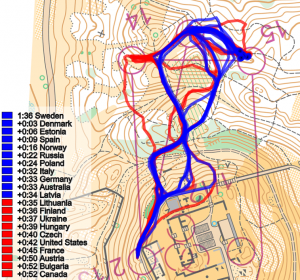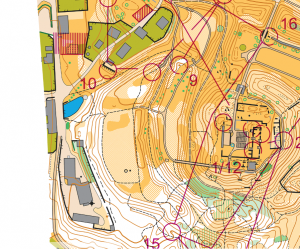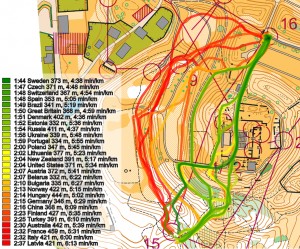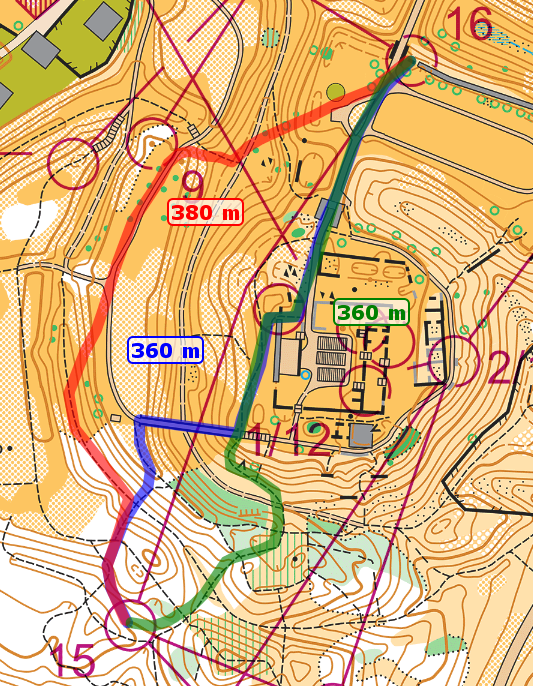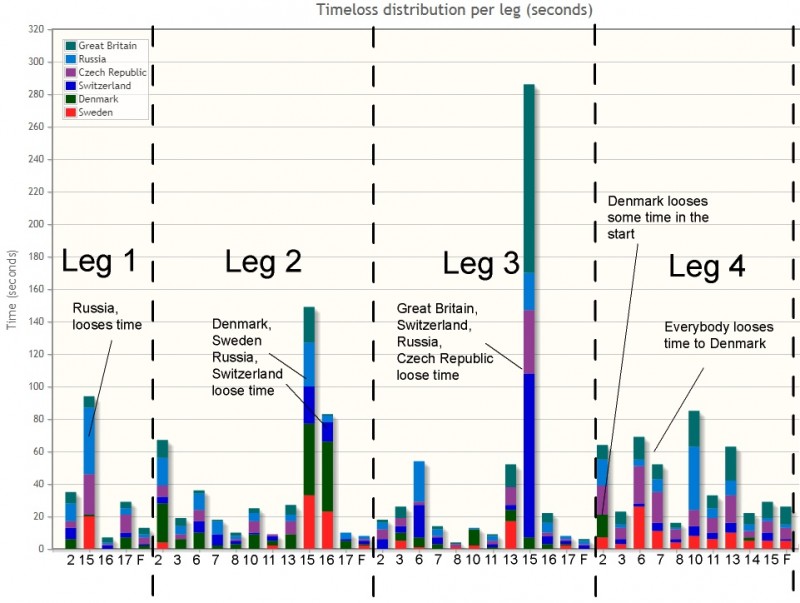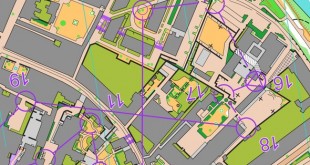[Updated with control-by-control analysis towards the bottom of the article] Big mistakes by the men decided the World Orienteering Championships Sprint Relay 2017 – a change compared to earlier editions were there have been small time differences between the top teams on the two men’s legs. Sweden took their first ever Sprint Relay title by running consistently and making fewer mistakes than the other teams. The terrain was perfect for the Swedes: Tough terrain with steep climbs and tough downhills.
The main reason for the big mistakes in the men’s class was two tricky controls in the forest towards the end of the course – control 14 and 15 which were placed in a steep area with complex contours. The above illustration shows how Switzerland’s Martin Hubmann and Great Britain’s Kris Jones lost 1:36 and 1:54 to Sweden’s Jonas Leandersson – respectively. This was one of the key points in the relay were current leading team Great Britain lost their chance to fight for a medal while Switzerland lost the possibility to fight for gold.
Below the other key points in the relay are presented and discussed in detail. If you are more interested in the technical challenges and the correct routechoices, there is a section further below which takes you through the course control by control and discusses the best routes on each leg.
WOC Sprint Relay, Leg 1

» See map in omaps.worldofo.com
WOC Sprint Relay, Leg 2

» See map in omaps.worldofo.com
Detailed analysis of the race development
The above race development graph shows the how the race developed between the common controls for the Top 6 finishers Sweden (red), Denmark (green), Switzerland (blue), Czech Republic (purple), Russia (cyan) and Great Britain (light green) at a glance. The first axis shows the time after the start of the relay, the second axis shows the time behind the current leading team. 13 different key situations are marked on the illustration with the letters A to M; these situations will be explained further in the following using the GPS-tracking.
Leg 1: Russia looses contact with the lead
Several teams loose time on the tricky courses on the first leg, but all favourite teams except Russia (at +46 seconds; Point A in the illustration) are within 10-12 seconds of leading team Switzerland where Elena Roos does an excellent job after the leg. Note that Czech Republic is 30 seconds behind – more than Czech Republic is behind the bronze medal at the end of the day.
Leg 2: Denmark out of battle for Gold
On the second leg it is the men’s turn to take responsibility. The favourite teams run mostly good races for the first part of the course but notably Denmark’s Andreas Hougaard Boesen loses contact with the leading group on the first two controls – partly due to route choice and partly due to running speed (point B):
Denmark was definitely one of the slowest on this control:
Sweden’s Jerker Lysell runs very well on the first part of the second leg, catching Switzerland’s Florian Howald and opening up a gap (Point C). One of the places were Lysell gains time on Howald is leg 7 shown below. Here Howald looses time by going to the left (red route) as the only runner.
After an arena passage, the athletes now move into the tricky forest part. Here there are big time differences to control 14/15 (point D in the illustration), Czech Milos Nykodym running more than 30 seconds faster than Sweden’s Lysell – and the other teams also gaining time on Lysell. Note however that Lysell has the long forking here while the other three teams have the short forking. The time difference between the forking seems to be in the order of 20-25 seconds. Thus it is actually Switzerland and Great Britain who do mistakes here (wrong route choice) while Lysell runs fairly well. These 20-25 seconds are valuable for Jonas Leandersson on the third leg – and part of the reason the gap gets so big. Denmark also has the long forking here, loosing 50 seconds to Czech Republic, on 13-15, but half of it is due to the long forking.
The leg to the 16th control is also a leg where both Sweden’s Lysell and especially Denmark’s Boesen loose time (point E in the illustration). Going around to the left is significantly longer, and gives you more steep hills. Lysell looses nearly 25 seconds to Czech Republic’s Nykodym here. Boesen looses nearly 45 seconds to Nykodym. Thus Boesen looses 1:30 to Nykodym between control 13 and 16, where 20-25 of those seconds are due to longer forking. Maja Alm would definitely have been happy to have some of those seconds in her battle with Sweden’s Helena Jansson on the last leg …
Leg 3: Big mistakes for Switzerland and Great Britain
Leg 3 is a very decisive leg. It starts already on the first part of the leg where Switzerland’s Martin Hubmann is one of the runners taking the wrong route to control 4, losing the lead and nearly 20 seconds (point F). Russia also takes the wrong route and loses around 20 seconds (point G). Here Switzerland goes from being in the lead to chasing 20 seconds behind – this might be part of the reason for Hubmann’s mistakes later on in the course.
The next interesting point on this leg is when the runners run into the forest again to control 14/15. Here Hubmann loses more than 1:30 (!) and Great Britain even more (Point H in the illustration). Part of it is due to the longer forking, but most is due to the mistake.
Leg 4: Simply too much even for Maja Alm
Maja Alm actually starts the leg with loosing some time to both Sweden’s Helena Jansson and Switzerland’s Sabine Hauswirth, mostly due to her forking being longer.
From there on Maja Alm has the speed we are used to. Already to the 4th control she takes a lot of time on Helena Jansson as Jansson does the same wrong route choice as Martin Hubmann did earlier (Point I in the illustration on top). Nearly 30 seconds on a single leg!
Then to the next control Alm does not take the best route choice. This does only cost her a few seconds, however, but it is enough to let Switzerland be in the game for a bit longer (point I).
From control 6 and on Maja Alm’s higher running speed lets her pull away – and take the victory. Switzerland also passes Czech Republic due to higher running speed.
Recap of the technical challenges: Analysis control by control
The above analysis has focused on why the winners won – and where the teams lost time. Here a quick rundown of the orienteering technical challenges control by control – good and bad solutions. The 3rd leg (men) is used for the analysis for simplicity. Click on the maps to get them bigger.
Control 1 and 12
There were some differences in the route choice to the first control – here you could either stay down in the valley (and run 30 meters longer) or run over the top and take 4-5 meters extra climb and a very steep downhill. Time differences here are a few seconds, and seem to vary more with athlete strengths/weaknesses than the routes themselves, but it seems to be better to keep in the valley even if Denmark did well over the top here. Going right definitely seems slower as you there both get extra length and the extra steep downhill – in addition to a steeper last climb without path.
Control 3
Going straight gives you an extra 12-15 meter climbs compared to all the way around (Portugal, red) – but it saves you 150 meters of running. Running in the middle (France, orange) is 70-80 meters longer than straight but saves you 7-8 meters of climb compared to direct. 150 meters for 7-8 meters climb is too much (even with steep, grassy hills), so here direct was clearly faster.
Control 4
On leg 4 you loose significant time (15-20 seconds) by going right because you first go all the way down in the valley, and then slowly up again. If you take the leftmost route choice, you use the bridge over the valley which saves you around 10 meters of climb – the total climb from the bottom and up is 20 meters – but you also have 10 meters climb on the left route choice. The forkings here are equal in time because you run through the forking controls afterwards. Good work!
Control 6
The forkings here are very similar in time – good work. A few runners (like Denmark’s Alm on the last leg) take a wrong route here going more to the right, but except for that nearly all make the right choices. For the rightmost 5th control the chance to make the wrong choice here is bigger than for the left (but still a small chance).
Control 7
Only small differences between the two alternatives. Note however that there is a third alternative (to the far left) which is only run by very few runners were you loose 10 seconds.
Control 9/10
The 9th control is a forked control were the rightmost control seems to be a few seconds faster than the left (only Sweden manages to run quite fast with the left control, loosing 2 seconds). If you have the left control you can loose extra time by taking the routechoice far to the left.
Control 14 (only men)
Control 14 is a forked control were the forking was not fair – the analysis indicates a 20-25 second time difference between the two alternatives. This is clearly too much in a Sprint Relay. Above the routes of the 2nd and 3rd leg are shown with blue for teams with the rightmost forking and red for teams with the leftmost forking. Only teams without significant control mistakes are included, and the teams far down on the results list with slower running speed are not included.
Due to the circumstances it was probably not decisive for the final medal result this time, but it could definitely have been decisive. Interestingly I heard before the start that Janne Salmi had said that there was probably a 20-25 second time difference between the forkings – it is strange that the course setters had not noticed this (or done anything about it) during their work with the courses.
Control 16 (only men)
This is one of the most interesting legs of the day, and you really have to study the map to understand why e.g. Denmark and Norway loose more than half a minute by going left (different variants of the red route in last illustration). The key point here is the bridge over the valley on the blue route in the last illustration, which saves you a 15 meter steep downhill and a following 15 meter steep uphill. In addition you have to run longer by going left, so it is clear that you can really loose time here. For the rightmost alternative (green in the last illustration) it might seem like you avoid going down in the valley, but actually you still have to go down and take all that extra climb, although the downhill is not quite that steep here. But the contours are so complex here that it is difficult to understand that the bridge helps you so much.
Recap of the race development (for the geeks)
The most important points on the illustration are
- Denmark’s Andreas Hougaard Boesen’s 2 minute time loss on the second leg (point B and E, in addition to several smaller mistakes and lower running speed) – this cost Denmark’s Maja Alm the chance to fight for gold on the last leg
- Point D were Sweden’s Jerker Lysell first has long forking and then does a route choice error on the second leg and gives away nearly a minute
- Point F where Switzerland’s Martin Hubmann looses contact with the leading group on the third leg due to wrong route choice to 4th control
- Point H where Switzerland’s Martin Hubmann and Great Britain’s Kris Jones make big mistakes in the forest
- Several key points on the last leg (I-M) – Jansson taking the wrong route, Alm taking a wrong route and Alm getting away due to higher speed
The below graph shows an overview of the time losses for the Top 6 teams between the common controls compared to the best split time for each split among these teams. The graph clearly shows how the men (leg 2 and leg 3) loose more time than the women (leg 1 and leg 4) – with the forest controls towards the end of each of the men’s leg giving most trouble. The other place on the courses with significant time losses is between control 3 and 6 – many runners took the wrong (southern) routechoice here, loosing 20-25 seconds.
 World of O News
World of O News

